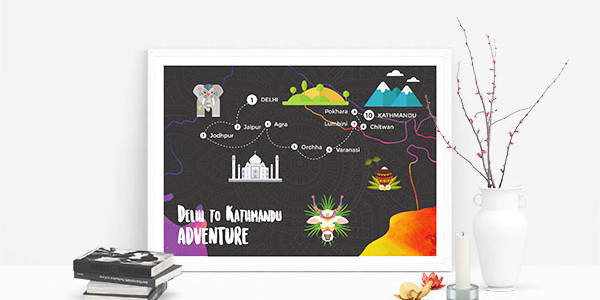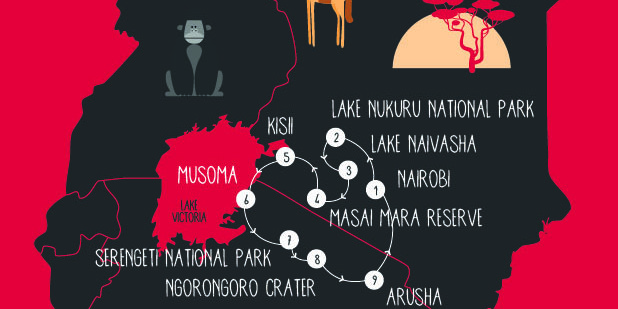Time to make true one of my life dreams: to visit South East Asia (feeling very sorry because I cannot do it to Laos, but thinking that will be the reason to come back in the future) and to discover the culture of three very different countries with an unique past.
The adventure will start with a 13 hours flight that will take me from UK to China. When I’ll get to Hong Kong I’ll take another flight (this one “only” 3 hours) that will bring me finally to Vietnam.
The arrival to Hanoi will be during the night, so I won’t have time to see more than the surroundings of the hotel and just the time to prepare everything to go on the road the day after.
Momento de cumplir uno de mis sueños: visitar el Sudeste Asiático (con el pesar de no poder visitar Laos, pero razón para volver en otro momento) y descubrir la cultura de tres países muy distintos con un pasado único.
La aventura comenzará con un vuelo directo de 13 horas que une Inglaterra y China. Al llegar a Hong Kong cogeré otro vuelo (éste de “sólo” 3 horas) que me llevará finalmente a Vietnam.
La llegada a Hanoi será prácticamente de noche, apenas dejándome tiempo de ver más allá de los alrededores del hotel y de preparar todo para poner pies en polvorosa al día siguiente, cuando la aventura realmente dará comienzo.

From Hanoi I’ll take a bus (approx. 4 hours) that will take me to Halong Bay, World Heritage site. Halong Bay is a breathtaking secluded harbour with 2,000 limestone islands rising from the emerald waters of Bac Bo Gulf. One of Vietnam’s most scenic regions, this area of about 1,500 sq. km is dotted with innumerable beaches and grottos, created over thousands of years by waves and wind.
I’ll spend two days on a boat, having the chance to swim in the famed South China Sea (known locally as the East Sea), as well as to explore caves filled with stunning stalactites and stalagmites, to spend the night on board, beneath a night sky alive with stars, to then come back the day after to land.
A 3.5 hours bus will take me to Hanoi train station, where I’ll be taking a night train in which I’ll spend the night while traveling to Hue.
Desde Hanoi cogeré un autobús (aproximadamente 4 horas) que me dejará en la Bahía de Halong (Patrimonio de la Humanidad). Es una bahía con más de 2.000 islas que emergen de las esmeraldas aguas del Golfo Bac Bo. Uno de los lugares más fotografiados de Vietnam, este área de 1.500 km cuadrados está dotada de innumerables playas y grutas, creadas a lo largo de miles de años por las olas y el viento.
Estaré dos días en un barco, teniendo oportunidad de nadar en el famoso Mar del Sur de China (allí conocido como Mar del Este),así como de explorar cuevas con estalactitas y estalagmitas, pasar la noche a bordo bajo un cielo estrellado, para al día siguiente volver a tierra firme.
Un viaje de unas 3 horas y media en autobús me dejará en la estación de trenes de Hanoi, donde cogeré un tren nocturno en el que pasaré la noche viajando hasta llegar a Hue.

I will stay 2 days in Hue, former imperial capital of Vietnam. I will start the visit of Hue on the back of a motorbike to visit the Imperial Citadel, which includes the Forbidden Purple City. The latter was almost totally destroyed during the Vietnam War’s Tet Offensive, and the gaping holes left by bombs give an idea of the destruction wreaked upon the country during the war. Next is Thien Mu Pagoda, considered by many to be the unofficial symbol of Hue. It’s an active Buddhist monastery with its origins dating back to 1601. I will also go to have a look to Dong Ba Market.
I will enjoy a dragon boat cruise on the Perfume River before getting back on the motorbike and riding to the royal tomb of Emperor Tu Duc.
After all, I will head South, traveling along the coast line by bus for around 4 or 5 hours, with a brief visit to the China Beach (known officially as My Khe Beach).
Estaré 2 días en Hue, antigua capital imperial de Vietnam. Comenzaré la visita montando en moto para llegar a la Ciudadela Imperial, donde está la Ciudad Prohibida Morada. Ésta fue prácticamente destruida durante la ofensiva Tet de la Guerra de Vietnam, y los agujeros dejados por las bombas dan una idea de la destrucción del país durante la guerra. Lo siguiente será la Pagoda Thien Mu, considerada por muchos el símbolo de Hue. Es un monaterio budista en activo que data de 1601. También iré al Mercado de Dong Ba.
Después haré un pequeño viaje en barco por el Río Perfume, antes de volver a coger la moto para ir a ver la tumba real del Emperador Tu Duc.
Lo siguiente será viajar hacia el sur, a lo largo de la costa, con una breve parada en la Playa China (conocida oficialmente como My Khe Beach), en un viaje de 4 ó 5 horas en autobús.

The next couple of days will be to visit Hoi An. Recently declared a World Heritage site, Hoi An is being beautifully restored and preserved. Known as Faifo to early western traders, it was one of South-East Asia’s major international ports during the 17th, 18th and 19th centuries.
From Hoi An I´ll take an internal flight to get to Ho Chi Minh City (1 hour).
En Hoi An pasaré otros dos días. Hoi An, recientemente proclamado Patrimonio de la Humanidad, Hoi An está siendo restaurada. Conocida como Faifo por los comerciantes del lejano Oriente, fue uno de los mayores puertos internacionales en los siglos XVII, XVIII y XIX.
Desde Hoi An tendré que coger un avión para llegar a Ho Chi Minh City (1 hora de viaje).

Formerly known as Saigon, Ho Chi Minh City is characterised by a vast array of sights and sounds, a blend of old and new, East and West. It is Vietnam’s largest city, and I will hopefully get to taste the Vietnamese street life (specially the street food!).
I will stay 3 days here, so I have in the to-do list a visit to the War Remnants Museum (opened in 1975); a day trip on a boat along the Mekong Delta, getting to Ben Tre to see coconut candy factory and sample the local candies for which this region is famous; to take a tuk-tuk; visit Tho town…
Then I will travel by bus through rural Vietnam and Cambodia (crossing the border) to Phnom Penh (approx. 7 hours).
Ho Chi Minh City, antiguamente conocida como Saigón, es la ciudad más grande de Vietnam y mezcla de viejo y nuevo, Este y Oeste. Aquí aprovecharé para descubrir la vida callejera vietnamita (¡y sobre todo los puestos de comida y mercados!).
Estaré 3 días aquí, y en mi lista de cosas que hacer y ver están la visita al Museo de la Guerra, abierto en 1975; un día navegando por el Delta del Mekong, parando en Ben Tre para ver cómo hacen los tan famosos dulces de coco de esa zona y en My Tho; montar en tuk-tuk; visitar el pueblo de Tho…
Cogeré un autobús para recorrer la Vietnam rural, cruzar la frontera con Camboya y llegar a Phnom Penh (unas 7 horas de viaje).

Phnom Penh, Cambodia’s capital, is set on a major junction of the Mekong and Tonle Sap rivers.
Here I’ll confront Cambodia’s tragic past on the Tuol Sleng Genocide Museum, a former school which served as a Khmer Rouge torture centre. It’s estimated that more than 20,000 people were held and tortured here. I will then head out to the Choeung Ek Memorial, where a stupa made up of some 8,000 human skulls marks the site of the infamous Killing Fields. This was the execution ground for the torture victims of Tuol Sleng.
After 2 days in Phnom Penh I will be taking a 6 hours-trip bus that will take me to Siem Rap. This will be my opportunity to look at the real Cambodia, hoping to make several stops at points of interest along the way.
Phnom Penh, capital de Camboya, es donde se unen los ríos Mekong y Tonle Sap.
Aquí aprovecharé para visitar retazos del triste pasado de Camboya bajo el poder de los Jemeres Rojos (visitando el museo del genocidio Tuol Sleng, antiguamente centro de tortura de los jemeres), el memorial Choeung Ek, donde 8.000 calaveras humanas marcan los llamados “Killing Fields” o campos de matanza, además de visitar otros templos y pagodas.
Tras dos días en la capital cogeré un autobús (6 horas) que me llevará a Siem Rap, aprovechando para hacer varias paradas en el camino descubriendo la Camboya real.

The town of Siem Reap is the gateway to Angkor. And my personal reason of this trip. I have a 3-days pass to visit the world-famous Angkor complex. These temples were built between the 9th and 13th centuries when the Khmer empire was the pre-eminent influence in South-East Asia. The temples were believed to represent the cosmic world and were set in perfect balance, symmetry and composition, scattered over an area of some 160 sq km.
I will then head to Battambang (4 hours by bus). Here, the second Cambodia’s largest city, I will try to see the “bamboo train”, but I will only stay here one day, before taking another bus that, after 9 hours and crossing the border with Thailand, will take me to Bangkok.
Siem Rap es la ciudad de acceso al majestuoso (y culpable de este viaje) Angkor Wat. Tengo entrada para 3 días a los templos del famoso complejo de Angkor. Los templos, construidos entre los siglos IX y XIII, ocupan un área de 160km cuadrados y se cree que representan el mundo cósmico, construidos en perfecto balance, simetría y composición.
Después viajaré hasta Battambang (4 horas en autobús). Aquí, la segunda ciudad más grande de Camboya, sólo pasaré un día, donde intentaré ver el “tren de bamboo”, antes de coger otro autobús que, tras 9 horas y cruzar la frontera con Tailandia, me llevará a Bangkok.

In Bangkok, famous for its tuk tuks, khlong boats and street vendors serving up delicious Thai food, I’ll enjoy the last 2 days of my trip, before taking a 3 hours flight that will take me to Hong Kong (China), and then take a 13 hours flight to get back to London.
Llegaré a Bangkok, capital de Tailandia, famosa por sus tuk tuks y vendedores de comida callejera. Aquí pasaré los últimos dos días del viaje, antes de coger un vuelo de unas 3 horas que me dejará en Hong Kong (China), para luego coger otro vuelo de 13 horas que me dejará de vuelta en Londres.



Have lots of fun and enjoy every minute of this great trip!!
That is exactly what I am doing. Thanks! x